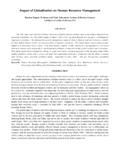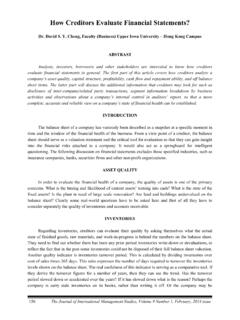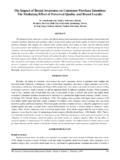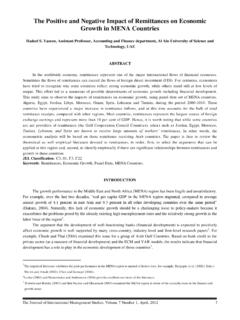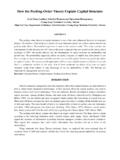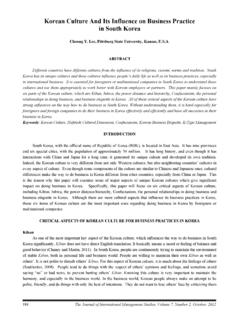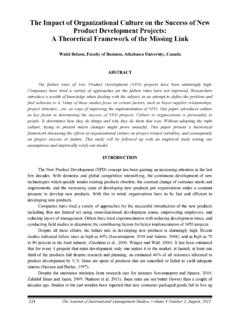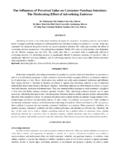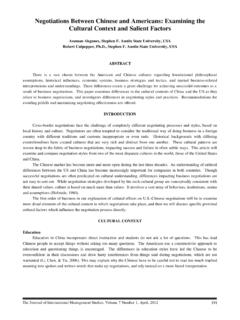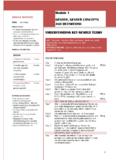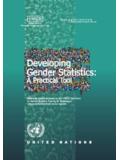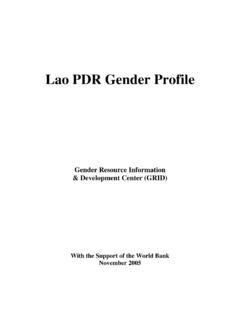Transcription of Emotional Intelligence, Transformational …
1 The Journal of International Management Studies, Volume 3, Number 2, August, 2008 1 Emotional intelligence , Transformational leadership and gender : Correlation and Interaction Possibilities F. William Brown and Michael D. Reilly Montana State University, USA ABSTRACT Mandell and Pherwani (2003) found a significant, predictive relationship between Emotional intelligence and leadership . Replicating their study in a manufacturing setting, we examine the possible relationships between leadership , Emotional intelligence , gender and organizational outcomes. Our results affirm the previously reported relationship between gender and leadership ; however, we are unable to find or confirm any evidence of the other reported relationships between gender , leadership and Emotional intelligence .
2 We suggest reasons why our study might more accurately describe the nature of the relationship between the variables of interest than the previous study. We also develop the implications of our results and possibilities for further study. INTRODUCTION From the earliest periods of recorded history, historians, academics, and social scientists have puzzled over the nature and determinants of leadership (Bass, 1990a; Bryman, 1996). Having been through numerous theoretical cycles, contemporary leadership theory has been dominated by the notion of Transformational leadership (TL) for approximately two decades. Numerous studies, done across a wide variety of cultures and organizational settings, have been examined in a meta-evaluation (Lowe, Kroeck, & Sivasubramanian, 1996) which affirms the efficacy of Transformational leadership on desired organizational outcomes.
3 Against this foundation researchers have turned their attention to personal characteristics which might influence TL in the hope of a more holistic and fully explanatory understanding of the social influence process. Although various forms of non-cognitive intelligence have long been suggested, rigorous scientific examination has only taken place in the past few years. An emerging concept of Emotional intelligence has attracted considerable attention among researchers and the possibility of a relationship with leadership has been preliminarily, but inconclusively, examined (Antonakis, J., 2003; Brown F. & Moshavi, D., 2005). The impact of gender on leadership and performance has been extensively examined ( Eagly & Johnson, 1990).
4 However, the direct relationship with Emotional intelligence and the possibility of an interaction between gender , Emotional intelligence , and TL remains largely unexplored. Mandell and Pherwani (2003), in what may be the singular examination to date, considered the relationships between gender , Emotional intelligence and leadership . They report significant, predictive relationships between those variables. This is an empirical study, utilizing a large and robust sample, which replicates and extends that study and examines the possible bilateral and interactive relationships among TL, Emotional intelligence , gender , and organizational outcomes. A more definitive understanding of these relationships would substantively contribute to the yet unresolved understanding of the possible relationship of Emotional intelligence and leadership and to the interaction of each of those with gender .
5 LITERATURE REVIEW & THEORETICAL DEVELOPMENT Transformational leadership Burns s (1978) narrative study of political leaders provided much of the impetus for the development of contemporary leadership theory. He concluded that leadership could be characterized as either transactional or Transformational , with the object of transactional leadership being the creation of a bargain to aid the individual interests of the persons or groups going their separate ways (p. 425). Conversely, Burns s Transformational leaders inspire the belief in followers that whatever the separate interests [they] might hold, they are presently or potentially united in the pursuit of higher goals, the realization of which is tested by the achievement of significant change that represents the collective or pooled interests of leaders and followers (p.)
6 426). Burns s work in the late 1970s revitalized leadership theory, which had fallen into a protracted malaise following considerable advances in the post WWII period (Hunt, 1999). The framing of leadership as being either Transformational or transactional quickly attracted the attention of researchers, particularly Bass and his colleagues (Bass 1985a, 1985b, 1990a, 1990b; Bass & Avolio, 1990; Conger & Kanungo, 1987, 1988; Hater & Bass, 1988; Yukl 1989). leadership researchers focused their scientific acumen on the examination and explication of Burns s model (Bass, 1985b). Following Burns s lead, The Journal of International Management Studies, Volume 3, Number 2, August, 20082 Transformational and transactional leadership were conceptualized as completely different processes.
7 From factor analyses of various samples of engaged leader/mangers Bass extracted five factors--charisma (later described as idealized influence), intellectual stimulation, individualized attention, contingent reward, and management-by-exception--in his original formulation. The first three factors were associated with TL and the latter two with transactional leadership (Bass, 1985a). Bass & Avolio (1990, 1994) made further distinctions between factors and unified the elements of transactional and TL into what they described as the Full Range model of leadership . The elements of the model arrayed leadership behavior from ineffective to effective.
8 The most effective behaviors, the so called Four I s of TL are described as Intellectual Stimulation, Individualized Attention, Inspirational Motivation and Idealized Influence. Contingent reward behaviors, a key component of transactional leadership , are described as being reasonably effective (Bass & Avolio, 1990, p. 24). Researchers using a variety of methods, across a variety of settings, have consistently concluded that the use of TL behaviors is associated with higher levels of organizational performance and positive employee attitudes (Bass 1985a; Avolio, Einstein &Waldman,1988; Hater and Bass 1988; Atwater and Yammarino, 1993; Sosik 1997). The efficacy of TL and certain transactional leadership behaviors have been further confirmed through meta-evaluation (Lowe, Kroeck, & Sivasubramanian, 1996).
9 This well established relationship gives rise to the first hypothesis in this study: Hypothesis 1: TL (TL) positively predicts desirable organizational outcomes (DO). This hypothesis seeks to determine if the well established relationship between TL and DO can be confirmed in this study. The objective is not so much to add to the already well established association, but to provide reassurance that the sample is representative and to lay the groundwork for an examination as to how Emotional intelligence (EI) and gender might impact that influence process. Emotional intelligence Compared with TL, the precise nature of EI and the structure and extent of its relationships to DO and leadership are considerably less clear.
10 Although the existence and importance of intelligences beyond memory and problem solving had long been recognized (Thorndike & Stein, 1937; Piaget, 1954/1981; Wechsler, 1940), the publication of the best-selling popular press book, Emotional intelligence (Goleman, 1995), attracted the first considerable attention from management researchers seeking to determine the power of non-cognitive intelligence to predict organizational outcomes or a possible dispositional relationship with leadership (Goleman, Boyatzis, & McKee, 2002; Sosik & Mergerian, 1999). These matters remain largely unresolved and are often in vigorous dispute (Antonakis, J., 2003, Locke, 2005). There are essentially three primary, interrelated issues which have inhibited the systematic assessment of possible relationships between EI, leadership and performance: (a) definition, (b) psychometric independence, and (c) measurement (Brown & Moshavi, 2005; Goleman, 1995, 1998; Cherniss, 2000, Cooper & Sawaf, 1997; Mayer & Salovey, 1993 Mayer, Caruso, & Salovey, 1999; Weisinger, 1998).
